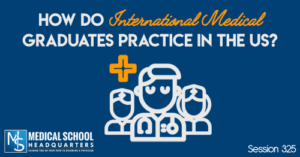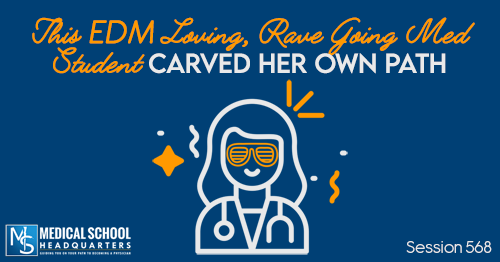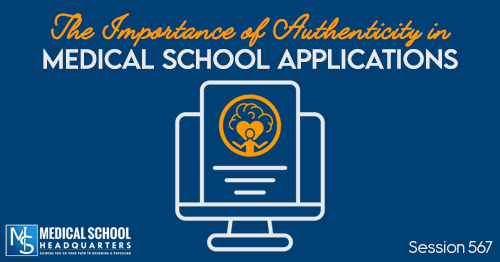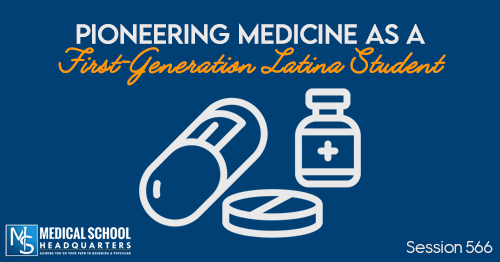Apple Podcasts | Google Podcasts

Session 325
When you go to an international med school, including the Caribbean, there are many steps you need to take to practice in the U.S., including going through the Educational Commission for Foreign Medical Graduates or ECFMG.
Specifically, we talk about the process of coming back to the U.S. (if you’re a U.S. citizen), if you go to an international medical school; or the process of coming to the U.S. if you’re not a U.S. citizen but you want to come to practice and do your training in the U.S.
ECFMG Vice President of Communications and External Affairs, Liz Ingraham, shares with us all information about the process for students coming back to the U.S. to practice.
Meanwhile, be sure to check out all our other podcasts on MedEd Media Network.
[03:03] The Role of ECFMG
ECFMG is a 62-year-old private, nonprofit organization that has been responsible for evaluating international medical graduates who wish to come to the United States and train.
They define an international medical graduate as a student or a graduate who received the basic medical qualifications or degree from a school outside the United States and Canada. Liz stresses that it’s the location of the medical school that makes one an international medical graduate, and not citizenship. U.S. students who pursue medical education abroad and receive their degree abroad are considered international medical graduates. Their first step in returning from education to pursue U.S. residency would be ECFMG and its program of certification.
'It's the location of a medical school, not citizenship that makes one an international medical graduate.'Click To Tweet[04:25] Why Go Through ECFMG?
The ECFMG was formed by prominent organizations in what they call the house of medicine. These organizations are responsible for the assessment, education, and training of physicians. They formed ECFMG in 1956 because of the number of interns and residents who were coming into serving U.S. hospitals and coming from schools abroad.
There are nearly 4,000 operating medical schools around the world, which vary widely by curriculum and facilities. The purpose of the certification is to assess whether international medical graduates regardless of what school they’re coming from and what their education has been like, whether they’re ready to enter U.S. training programs accredited by the ACGME.
Liz clarifies that ECFMG is not involved in the accreditation of medical schools. In fact, ECFMG has a three-fold requirement classification, many of which focus on the individual position. There are examinations in the medical and clinical sciences and clinical skills, USMLE Step 1, Step 2 CS and Step 2 CK. Those are among the same examinations taken by U.S. medical school students and graduates. Additionally, ECFMG has a credential requirement where they look at the final medical diploma, final medical school transcript, and they verify their authenticity back with the medical schools that issued them.
They also have a certain set of requirements for the medical school, one of which is for them to be listed in the World Directory of Medical Schools, the premier resource on medical schools around the world. And that their students and graduates be eligible for licensure in the country of medical education.
If you’re interested in learning more about their Accreditation 2023 Initiative, check their website. By 2023, ECFMG will require that an applicant’s medical school be appropriately accredited. This means it will be accredited by an accrediting agency recognized by the World Federation for Medical Education. So there will be some additional requirements for medical schools coming in the future.
In addition to their 2023 requirement, they published a medical school selection guide, which is a checklist of things students should be looking at if entertaining an international medical school.
[09:20] Common Issues IMG’s Face Going into the U.S.
International medical graduates need to come through the ECFMG, which means they have to meet the requirements for medical schools, exams, and primary source verification of those scored medical education credentials.
The number of U.S citizens pursuing medical education abroad is trending upward. About a third or even more of physicians they certify every year are U.S. citizens who have gone to international school and they’re coming back for residency positions.
ECFMG certifies about a thousand applicants each year and well over 3,000 physicians every year that are going through the ECFMG process, competing for residency positions. As far as challenges, U.S. citizens thinking about going to school abroad really need to educate themselves about match rates that U.S. citizens and non-citizens have in obtaining that first year of residency position.
For 2018, the match rate for U.S. citizens IMG was in the high 50s. This means that 40+% of the U.S. IMGs did not match for a first-year residency position.
That said, they’re not involved in helping international medical schools meet requirements or promote their schools. So they encourage students to do their due diligence and do the research themselves.
The USMLE pass rate information on the USMLE website is a good starting point.
[12:15] When to Start Contacting ECFMG
Medical students and graduates can begin the ECFMG certification process by getting a USMLE ECFMG number and then apply for ECFMG certification, which is a very brief application. Once completed, they can apply for the first examination as long as one has met the ECFMG requirements, which have generally been completed during the first two years of medical school. The exact requirements are listed on the ECFMG website. Many of their applicants have already graduated from medical school by the time the organization hears from them.
[13:30] Finding the Proper Timeline
The response rates per school basically vary. ECFMG is increasingly doing electronic web-based verification and so they’re very quickly eliminating the paper-based process. The current process is they mail a copy of the credential to the school and wait for a response mail.
Moreover, one may not need the credential requirements for certification to engage with the match. For the rank order deadline for the match, one only needs to have passed all the exams required for ECFMG certification. However, this process needs to be complete before the program start date typically around July 1.
'One does not need to have the credentials verified by the school in order to participate in the match.'Click To Tweet[14:43] Examinations
ECFMG uses the United States Licensing Examination or USMLE to meet its examination requirements. USMLE is owned by the National Board of Medical Examiners and the Federation of State Medical Boards. It is used primarily to grant the initial license to practice medicine and therefore is also taken by U.S. medical students and graduates at various stages in their career.
Other exams are Step 1 and Step 2 CK and they are given in Prometric test centers around the world. Step 2 CS, the second component of the Step 2 examinations is the clinical skills component and ECFMG does partner with the National Board of Medical Examiners to deliver that examination at six test centers in the United States. So ECFMG has a role in running the test centers and administering the examination.
[16:30] The ECFMG Process
Students have to complete the two initial steps of the application: applying for the identification number and then applying for ECFMG certification, a short six-question web-based application. It includes an identity verification component. Then once they meet the medical examination requirements, they can apply for the exams which can be taken in any order as one meets the educational requirement.
[17:45] The Process for Non-U.S. Citizens
Liz says the process is almost identical to that for U.S. citizens who go to medical school abroad and then come back to the United States. Again, an IMG is one who goes to medical school and obtains that final medical school qualification from a medical school outside the U.S. and Canada. The steps are identical. The one place in the process that they’ve not talked about beyond examinations and certifications is that those individuals will likely need an appropriate visa to engage in graduate medical education in the United States. U.S. citizens do not need that visa should they match to a position and want to participate.
You can’t apply for the two appropriate visa types until you have a contract. First, you need to meet the exam requirements for certification, participate in the match, and successfully match to a program. Once you have that contract for the residency program, then you can begin the process of applying for a visa. That process really starts during match week in March. The individual has those several months until typically July 1 to obtain that visa.
'ECFMG is the sole sponsor for the most common visa by non-U.S. citizen IMG to participate in graduate medical education and that is the J-1 Visa.'Click To TweetThe two visas that are commonly used for non-U.S. citizens to participate in U.S. graduate medical education are the J-1 visa and the H1B visa. For the J-1 visa, ECFMG is the sole sponsor designated by the U.S. Department of State. So they sponsor all positions in clinical training programs in the U.S. who are not U.S. citizens. It is a cultural and educational exchange visa. On the contrary, the HIB visa is a temporary work on a specialty occupation that is an employment visa. It’s sponsored by the employing hospital.
[21:00] Visa Challenges with the Current Administration
Liz admits that the last couple of years have been challenging with respect to the immigration environment in the U.S. At ECFMG, they’re watching this carefully. They’re concerned that they continue to be a great training location for the best and the brightest. Currently, the visa restrictions in place are essentially not accepting the ability of folks to attain visa sponsorship, obtain the visa, and come in. As a result, people may choose another training location.
That being said, people from North Korea were impacted and so they no longer have applicants from North Korea as well as those from Syria and Venezuela. For now, there are no legislative barriers for the majority of folks who are non-U.S. citizens who want to train in the U.S.
[22:25] Addressing the Shortage of Physicians
ECFMG doesn’t recruit physicians to come to the United States. But they’re here for the students when they make that decision to pursue training in the U.S. They’re here to evaluate them, certify them once they meet the requirements, and maintain a qualified pool of IMGs from which program directors can select. That said, a full 25% of IMGs both in training and practice in the U.S. are international medical graduates. That’s more than 260,000 physicians as of the end of 2017. Hence, IMGs play a huge role and ECFMG’s role is to ensure that those who compete and enter those positions meet minimum qualifications to do so.
“In order to meet the examination requirements for ECFMG certification, an individual needs to obtain the USMLE recommended minimum passing score.'Click To TweetECFMG does not set requirements that are different or separate from those set by the USMLE program. Individual medical schools, in fact, thousands around the world, may set individual requirements. So they highly encourage students to check in on requirements for progression with their medical school.
ECFMG doesn’t get detailed information or track folks as they are matched as they enter and progress through graduate medical education, with the exception of those positions they sponsor for the J-1 visa, which has to be renewed annually. They’re in touch closely with these folks and their host institutions to make sure they’re meeting the sponsorship requirements. Currently, there are about 11,000 non-U.S. citizen physicians at all levels of training in the United States.
[25:40] The Risk of Losing a J-1 Visa
Check out ECFMG’s J-1 visa sponsorship section to learn about their requirements for obtaining and maintaining J-1 visa sponsorship though ECFMG.
Ultimately, Liz recommends that those students who want to study internationally and come back to match at a U.S. program, should engage with ECFMG early, not necessarily as an applicant, but one who is engaged with their social media, their email newsletters, fact sheets, etc. Over time, the readers will absorb information about some of the issues, requirements, and some of the important points they need to deal with.
Liz names the top resources available such as the ECFMG Reporter Email Newsletter. Read the Certification Fact Sheet to give you an overview of the process from the moment one applies for an ID number, all the way through getting the visa and progressing through. It’s not easier as a U.S. citizen to obtain the ECFMG certification and get back into the United States for graduate medical education and training. That being said, there are a number of organizations that asses and train physicians as they progress from medical school, through training, and ultimately to licensure. The more prepared they are, they’re more likely to keep everything organized and not miss deadlines.
'ECFMG is really just the start of the process.'Click To Tweet[28:35] Ask Those Hard Questions
We highly encourage you yo look at the NRMP match data as well as board passing rates and match rates for the schools. Really dig deep and ask those hard questions. For instance, about what percentage of students do they let sit for the USMLE exam. International medical school and U.S. medical schools will have a competency exam for students to make sure they’re ready to sit for the exam.
'Ask those hard questions to make sure that you're going to school that is going to serve you well.'Click To TweetLinks:
World Directory of Medical Schools











